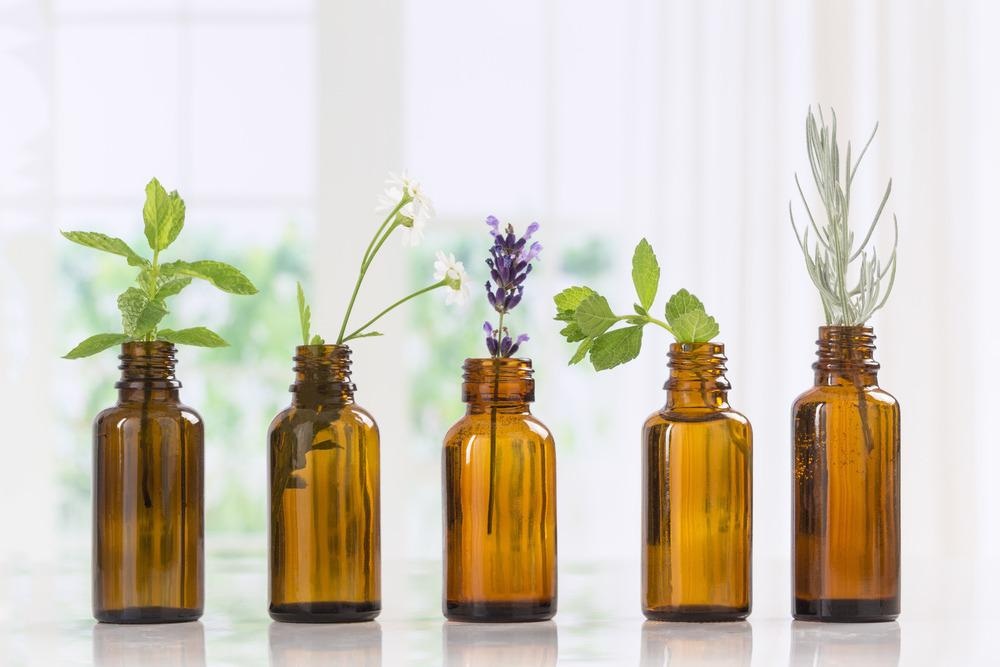The first thing to know about essential oils is that "essential" refers to the fact that they have an essence, not necessarily that we can't do without them. Essential oils are used for many different purposes, including flavoring, cosmetics, perfumes, and scenting, but they should not be confused with perfumes and fragrances. They have many pharmaceutical, medical, herbicidal, and pesticidal uses. Essential oils can be very, very useful but also quite dangerous if not used properly.

Image Credit: JPC-PROD/Shutterstock.com
History of Essential Oils
The first recorded use of essential oils was by the physician Ibn al Baytor in what is now Spain around the beginning of the 13th Century. At that time, they were classified as the essence of whatever plant they were sourced from.
Now they are known by their chemical names, for example, methyl salicylate rather than the "essence of wintergreen." Essential oils originate in plants and are components found in flowers, leaves, rhizomes, seeds, fruits, wood, and bark.
What are Essential Oils
Essential oils are usually complex mixtures of volatile secondary metabolites from plants that can be extracted by distillation, expression, or solvent extraction. They are predominantly terpenoid or phenolic synthesized by specialist cells from isoprene monomers (C5H8, or (CH2=C(CH3)CH=CH2)). They often also contain Oxygen, Nitrogen, and Sulfur in their functional groups. Well over thirty thousand terpenoids have been isolated from plants. Chirality in the structure of essential oils is an important feature. Different enantiomers can have very distinct organoleptic characteristics.
Essential oils are different from fixed or fatty oils. They have high vapor pressure at room temperature and hence evaporate completely if dropped on filter paper, leaving no visible stain. Essential oils are chemically classified as alcohols, esters, ethers, ketones, aldehydes, amines, amides, phenols, and heterocyclics. They are predominantly terpenes (about 80%), and over three hundred low molecular weight volatile compounds have been identified, which could have beneficial properties.
Essential oils are complex molecules that often require sophisticated equipment such as gas chromatography, mass spectrometry, infrared spectrometry, nuclear magnetic resonance, or High-Performance Liquid Chromatography to identify them.
Uses of Essential Oils
Plants use essential oils to increase their fecundity and chances of survival. Plants use essential oils in antagonistic ways to defend themselves against insects and animals eating them or to inhibit competition from other plants. They also use essential oils to attract pollinators or other resources.
Humans use them for their medicinal properties, flavoring, pigmentation, and as recreational drugs. There are essential oils that can help against all of the WHO's (World Health Organisation) top ten killer diseases. Aromatherapy is based mainly on the use of essential oils and can be used to treat many conditions. Research into the composition and benefits of essential oils is ongoing. The pharmacological and medicinal properties of many of these compounds are still being discovered.

Image Credit: Africa Studio/Shutterstock.com
Harvesting Essential Oils
Extraction of essential oils presents challenges as they are often thermosensitive and transform into different compounds when heated. They are also prone to oxidation, hydrolysis, and photo-oxidation. Essential oils can be extracted by steam distillation, but solvent extraction or supercritical fluid extraction are often used because they can operate at lower temperatures and essential oils are not heat resistant. Another technique used is microwave-assisted distillation. Sometimes they are extracted by simply pressing the sample.
Essential oils have a high degree of variability because natural processes produce them. Variability depends on intrinsic factors such as the plant's interaction with the environment, its maturity, and even the time of day harvesting can influence the oil's composition and purity.
Uses for Essential Oils
The beneficial characteristics of essential oils sometimes involve different chemical elements of the compounds.
Antimicrobial Activity
The hydrophobicity of the essential oil allows it to disrupt the cell membrane and cause leakage and cell death. Functional groups such as aldehydes and phenols are more active than ketones and esters. The presence of a hydroxyl group or phenolic ring increases the microbial effectiveness. Essential oils are more effective against gram-positive microbes than gram-negative microbes.
Antioxidant Ability
Phenolics and compounds with double bonds show good antioxidant ability. Essential oils that can scavenge free radicals may play a role in disease prevention, such as heart and brain diseases and immune system debilitation.
Anti-inflammatory activity. Inflammation is the body's natural reaction to tissue injury or infection. Essential oils can be used to treat inflammatory diseases such as rheumatism, arthritis, or allergic reactions. Alpha terpinol (C10H18O) inhibits the release of histamines by reducing the production of inflammatory compounds. The anti-inflammatory action may also be aided by essential oil's interaction with signaling within the affected cells.
Cancer Chemoprotection
Essential oils of garlic and turmeric have been discovered to reduce cancer cell activity. Sulfur compounds in these oils appear to break the bonds between carcinogenic compounds, which may induce apoptosis in cancer cells. They also initiate the release of detoxifying enzymes, making the compounds soluble, allowing them to be excreted in the urine.
Cytotoxicity
Essential oils are lipophilic, allowing them to cross the cellular membrane and make it porous, damaging bacteria. They may also coagulate the cytoplasm. They also show antiviral activity. Alpha terpene has also been observed to damage the viral envelope of the herpes simplex virus. The compounds exhibiting these properties are mainly alcohols, phenols, and monoterpene aldehydes. They are effective against some bacteria, viruses, fungi, protozoa, mites, and other parasites, making them useful in human pathology and protecting agricultural and marine products. Lab studies have shown that the essential oil of cypress rotunda is effective in killing leukemia cells.
Allelopathic activity
Phytotoxicity of essential oils is being investigated for the development of biodegradable herbicides. Essential oils with a high percentage of oxygenated monoterpenes are the best herbicides. The most effective compounds are alcohols and ketones, with aldehydes and phenols being slightly less effective.
Repellant and Insecticidal activity
Essential oils have a variety of insecticidal properties, which make them suitable for protecting against granary pests such as rice weevils and flying pests such as whitefly. Volatile monoterpenes can be inhaled, ingested, or absorbed through the skin of the insect. Some products like citronella have well-known mosquito repellent properties and have been used for many years.
Continue Reading: The Chemistry of Baking Here
Further Reading
Last Updated: Feb 25, 2022